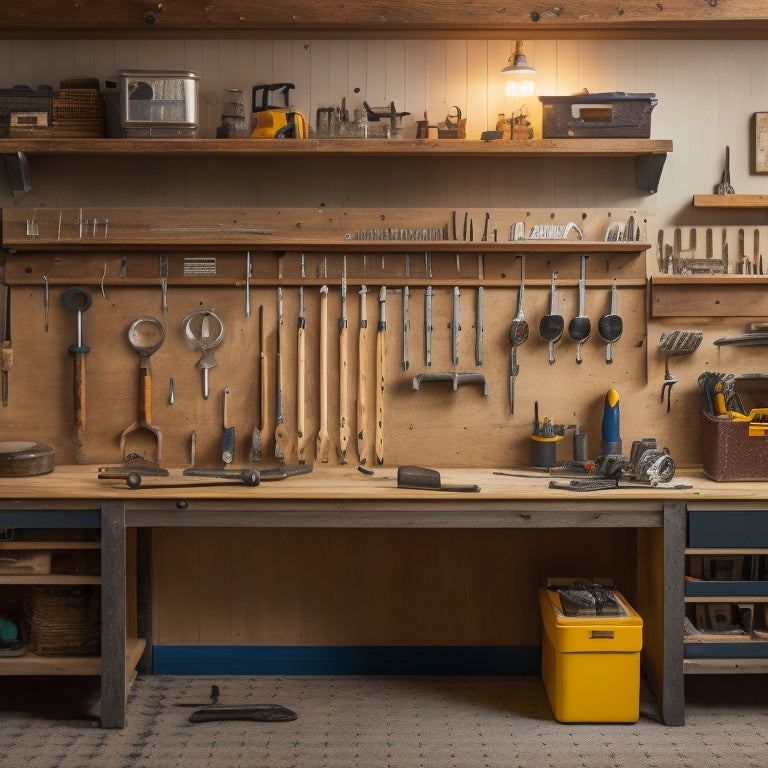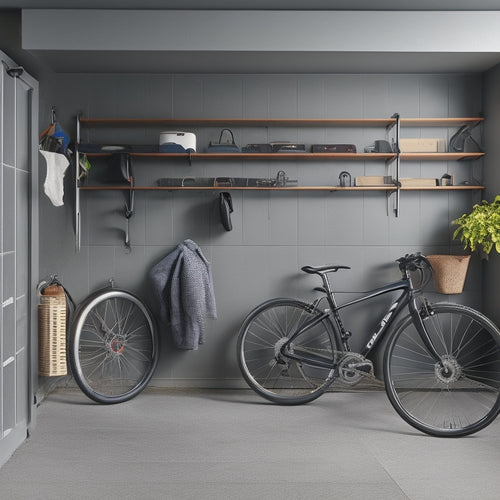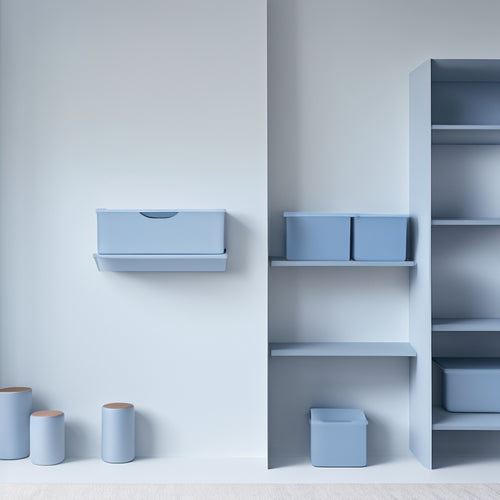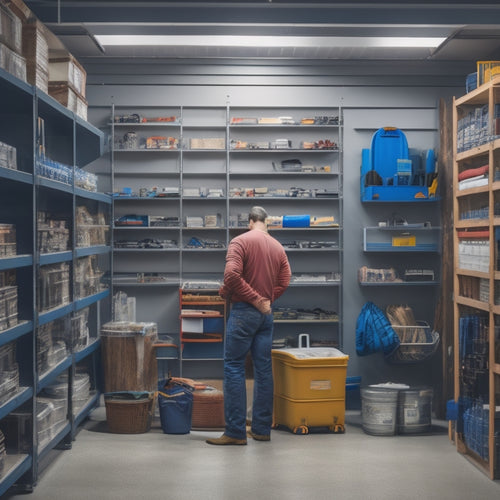
What's the Best Way to Store Your Tools?
Share
You need a tool storage system that's tailored to your unique work style and workflow. Store similar tools together, and use storage bins for small parts, labeling them for quick identification. Install shelving units or cabinets along walls, and consider a layout with workbench, storage, and assembly zones. Keep frequently used tools easily accessible, and allocate space based on tasks performed frequently. By optimizing your storage, you'll clear floor space, reduce clutter, and make tools easily accessible, ultimately streamlining your entire work process. And, with a well-designed system, you'll be able to find exactly what you need, right when you need it.
Key Takeaways
• Store similar tools together and categorize them by type, frequency, or project to optimize accessibility and reduce clutter.
• Designate specific areas for each type of tool and assign a specific place for each tool to develop muscle memory for tool locations.
• Utilize vertical space for storage, invest in multi-functional tools, and consider clever storage solutions like shelves and baskets to maximize space efficiency.
• Implement a tool organization system that works for you, such as tool inventory, digital labels, tool zones, and a First-In-First-Out system to save time and frustration.
• Prioritize tools based on frequency of use and store frequently used tools in easy-to-reach locations, placing less frequently used tools in harder-to-reach areas.
Customized Tool Storage Solutions
You can create customized tool storage solutions by designing a layout that caters to your specific tool collection and workflow. This means grouping similar tools together in what's called 'tool clusters.'
For instance, you can store all your drilling tools, such as drills, bits, and drivers, in one area. This clustering approach makes it easy to find the tool you need when you need it.
To further enhance your customized storage solution, consider using storage bins to keep small parts and accessories organized. Label each bin so you can quickly identify what's inside. This will save you time and frustration when searching for that one specific part.
You can also use bins to store tools that you don't use frequently, keeping them out of the way but still accessible.
Maximizing Workshop Storage Space
Now that you've optimized your tool collection with customized storage solutions, it's time to focus on maximizing the storage space in your workshop itself. To do this, you need to think strategically about floor utilization. Consider installing shelving units or cabinets along the walls to keep frequently used tools within easy reach. This will also help keep the floor clear, allowing you to move around comfortably.
Don't neglect the often-wasted space in corners. Corner optimization is key to making the most of your workshop's real estate. Invest in corner shelves, baskets, or carousels that can hold items like sandpaper, drills, or other small tools. These clever storage solutions will help keep your workshop tidy and organized.
Tool Organization for Efficiency
By categorizing and grouping similar tools together, such as all drilling equipment or measuring devices, you can create a logical and efficient organization system that saves time and reduces frustration.
This approach allows you to quickly find what you need, when you need it, and gets you back to work faster. A well-organized tool collection also helps you maintain a smooth work flow, as you're not wasting time searching for misplaced tools or equipment.
To take it a step further, consider assigning a specific place for each tool or group of tools. This can be as simple as designating a specific drawer or shelf for a particular type of tool. By doing so, you'll develop muscle memory and instinctively know where to find what you need, further streamlining your work process.
With a system like this in place, you'll enjoy significant time savings and be able to tackle projects more efficiently. You'll be amazed at how much more you can accomplish in less time, and how much less stress you'll feel in the process.
Designing a Dream Workshop
With your tools organized and categorized, it's time to create a workshop layout that maximizes your newly found efficiency. Your dream space should be tailored to your specific needs and workflow. Consider the tasks you perform most frequently and allocate space accordingly.
Here's a suggested layout to get you started:
| Zone | Description | Tools/Equipment |
|---|---|---|
| Workbench | Central workstation for projects | Table saw, drill press, sanders |
| Storage | Shelving for less frequently used tools | Hand tools, power tools, accessories |
| Assembly | Area for assembling projects | Workbench, clamps, measuring tools |
When designing your workshop layout, remember to leave enough space to move around comfortably. A well-planned layout can increase productivity and reduce frustration. Consider investing in mobile workstations or carts to optimize your workflow. By creating a dream space that's tailored to your needs, you'll be able to focus on what matters most – creating something amazing.
Pegboard Systems for Woodworkers
You can maximize your workshop's storage capacity and keep your tools within easy reach by installing a pegboard system, a versatile and customizable solution that's particularly well-suited for woodworkers.
When it comes to pegboard planning, consider the layout of your workshop and the tools you use most frequently. Place your pegboard in a convenient location, such as near your workbench or above a countertop.
Next, think about tool ergonomics - you want to position your tools in a way that minimizes strain and maximizes efficiency. For example, hang your most-used tools at eye level, and reserve lower hooks for heavier or less-frequently used items. You can also add bins, baskets, or trays to store small parts and supplies.
To get the most out of your pegboard, consider investing in a starter kit that includes a variety of hooks, bins, and accessories. You can always add or adjust components as needed.
With a well-planned pegboard system, you'll be able to quickly find the tools you need, freeing up more time to focus on your woodworking projects.
Custom Cabinets for Tools
Custom cabinets offer a tailored solution for storing your tools, allowing you to design a system that perfectly fits your workshop's unique needs and layout. You can choose from various cabinet materials, such as wood, metal, or composite, depending on your budget, style, and durability requirements.
Consider the tool aesthetics you want to achieve – do you prefer a modern, sleek look or a traditional, rustic feel? This will help you decide on the cabinet design, color, and hardware.
When designing your custom cabinets, think about the tools you need to store and how you want to access them. You may want to include features like adjustable shelves, drawers, or compartments to keep your tools organized and within reach. Consider the size and shape of your tools, as well as any specific storage requirements, such as humidity control or protection from dust and debris.
Streamlining Tool Accessibility
Effectively organizing your tools in easy-to-reach locations can greatly reduce the time spent searching for them, making your workshop a more productive space. To achieve this, you need to identify your tool paths - the routes you take to access your tools while working on a project. By mapping out these paths, you can prioritize your tools based on their frequency of use and place them accordingly.
For instance, place your most frequently used tools in easy-to-reach locations, such as the top shelf of your cabinet or in a nearby drawer. Less frequently used tools can be stored in harder-to-reach areas or on higher shelves. This access priority system ensures that you're not wasting time searching for the tools you need.
Additionally, consider the workflow of your projects and store tools in the order you'll need them. This streamlining of tool accessibility will save you time and energy, allowing you to focus on the task at hand. By optimizing your tool storage, you'll be able to work more efficiently and effectively.
Tool Storage for Small Shops
In small shops where space is limited, making the most of available storage is crucial, and this often means getting creative with tool storage solutions. With budget constraints, you need to think outside the box to optimize your space.
Here are some practical tips to help you store your tools efficiently:
-
Use vertical space: Install hooks, bins, or shelves on walls and ceilings to maximize storage capacity.
-
Choose multi-functional tools: Invest in tools that serve multiple purposes to reduce the number of tools you need to store.
-
Utilize hidden spaces: Make the most of hidden areas like under-bench storage, hollowed-out workbenches, or secret compartments.
- Label and categorize: Organize your tools by category and label each storage area to ensure easy access and visibility.
Modular Storage Systems
You can create a flexible and adaptable tool storage system by investing in modular storage components that can be easily rearranged or added to as your needs change. This approach provides tool flexibility, allowing you to adjust your storage setup as your tools and projects evolve.
Modular storage systems typically consist of individual components, such as bins, drawers, and shelves, that can be combined to create a customized storage solution. When selecting modular storage components, consider the types of tools you need to store and the space available in your workshop.
Look for components that are designed to work together seamlessly, ensuring system integration and a cohesive look. For example, you might choose a modular cabinet with interchangeable bins and drawers that can be rearranged as needed.
Personalized Tool Stations
When setting up your personalized tool station, you'll want to explore a tool organization system that caters to your specific needs.
This might involve customizing your storage solutions to fit your most frequently used tools, ensuring they're always within easy reach.
Tool Organization Systems
Create a personalized tool station by designating a specific area for each type of tool, ensuring that everything has a designated home and is easily accessible. This will save you time and frustration when searching for a specific tool.
To take it to the next level, consider implementing a tool organization system that works for you.
Here are some ideas to get you started:
-
Tool Inventory: Take stock of the tools you have and categorize them by type, frequency of use, or project type. This will help you identify what you need to store and how to organize it.
-
Create Digital Labels for each tool, making it easy to identify and locate them.
-
Assign a specific Tool Zone for each type of tool, such as a drill zone or a saw zone.
- Implement a First-In-First-Out system, where you store your most frequently used tools in an easily accessible area.
Customized Storage Solutions
With your tool organization system in place, now it's time to think about customized storage solutions that accommodate your specific tool collection and work style.
You've got a unique set of tools, and you use them in a way that's all your own. Customized storage solutions, or personalized tool stations, take into account your tool preferences and storage psychology. They're designed to optimize your workflow, reduce clutter, and make your tools easily accessible.
Think about how you work. Do you have a lot of heavy machinery or delicate electronics? Do you prefer to work in a specific area or move around the garage? Consider these factors when designing your customized storage solution.
You might want to invest in a modular storage system that can be rearranged as your needs change. Or, you might opt for a fixed storage solution that's specifically designed for your most frequently used tools. Whatever you choose, make sure it's tailored to your unique needs and work style.
Frequently Asked Questions
Can I Use a Pegboard in a Humid or Outdoor Environment?
You're right to worry about humidity, but you can still use a pegboard outdoors if you choose a weather-resistant material, like stainless steel or marine-grade plastic, and apply a rust-inhibiting coating to protect it.
How Do I Prevent Tool Rust in My Storage System?
To prevent tool rust, you'll want to focus on moisture control and rust inhibitors in your storage system. Use silica gel packets or a dehumidifier to keep the air dry, and apply rust-inhibiting sprays or waxes to your tools.
Are There Any Tool Storage Solutions for Left-Handed Users?
"As a lefty, you're not alone in your quest for tool storage harmony. Look for solutions featuring left-handed ergonomics, and don't settle for anything less than ambidextrous designs that cater to your unique needs."
Can I Customize My Tool Storage System for Specific Tasks?
You can tailor your storage system to specific tasks by implementing task-based organization, creating project-specific stations that hold exactly what you need, and labeling each station so you can quickly find what you're looking for.
Are There Any Eco-Friendly Tool Storage Options Available?
You're as keen on going green as a freshly picked Granny Smith apple! Look for eco-friendly tool storage options made from sustainable materials, and check out brands like EcoFlow and GreenWorks, which prioritize the planet's well-being.
Related Posts
-

Large Wall Hooks to Maximize Garage Space
You can effectively double your garage's storage capacity by installing large wall hooks that keep items off the floo...
-

Small Storage Bins to Maximize Shelf Space
When maximizing shelf space, you want to make the most of every inch. Small storage bins are the answer, but choosing...
-

Building Garage Shelves in 7 Easy Steps
You're about to convert your garage into a highly functional storage space by building custom shelves in just 7 easy ...


